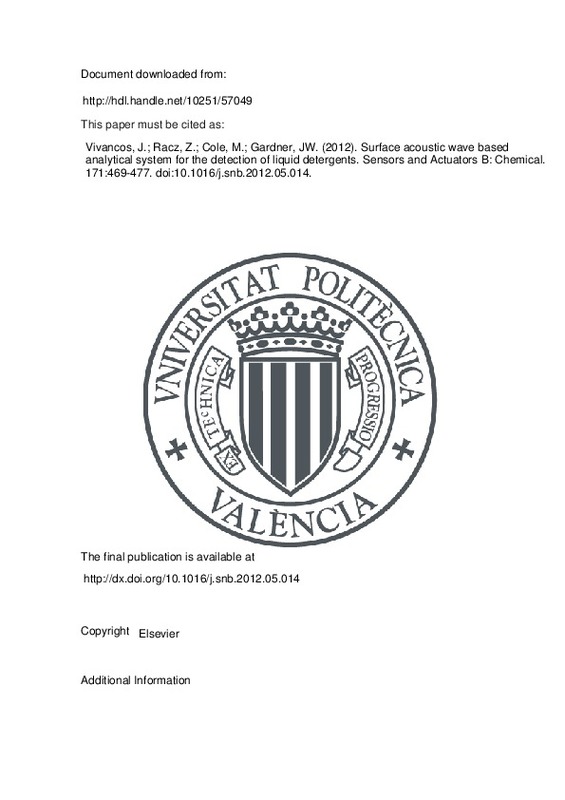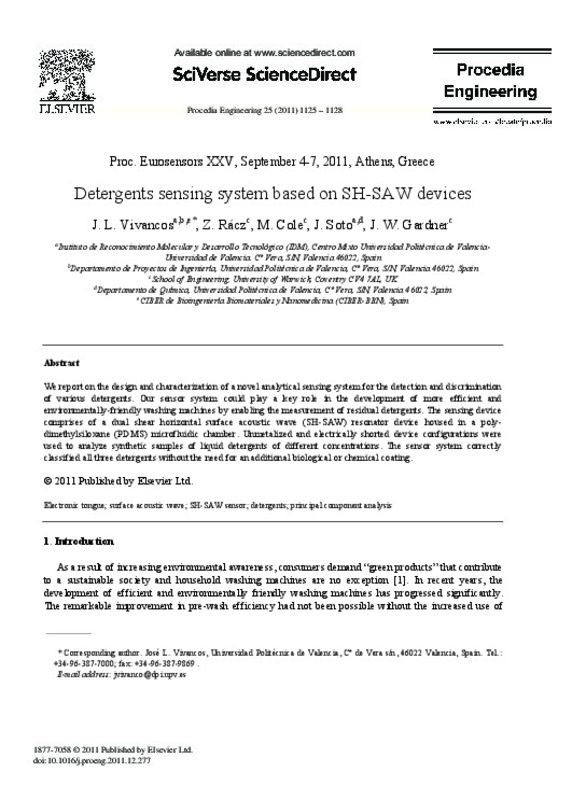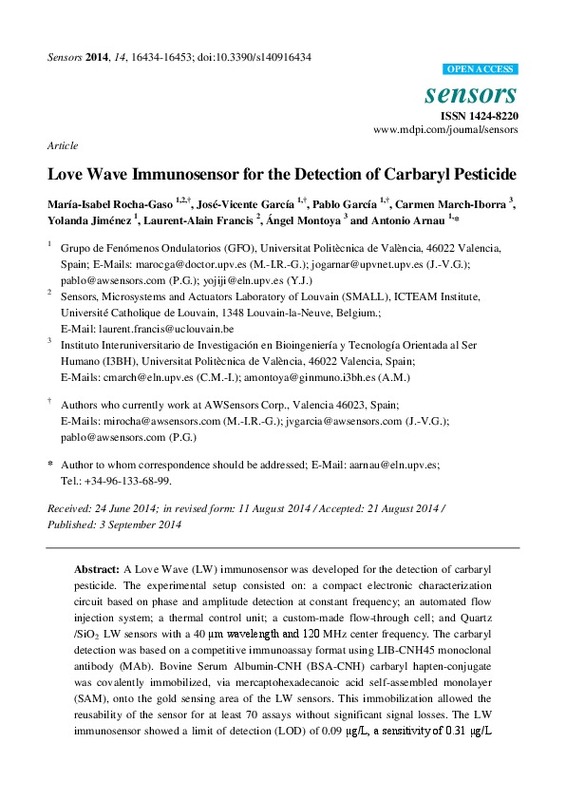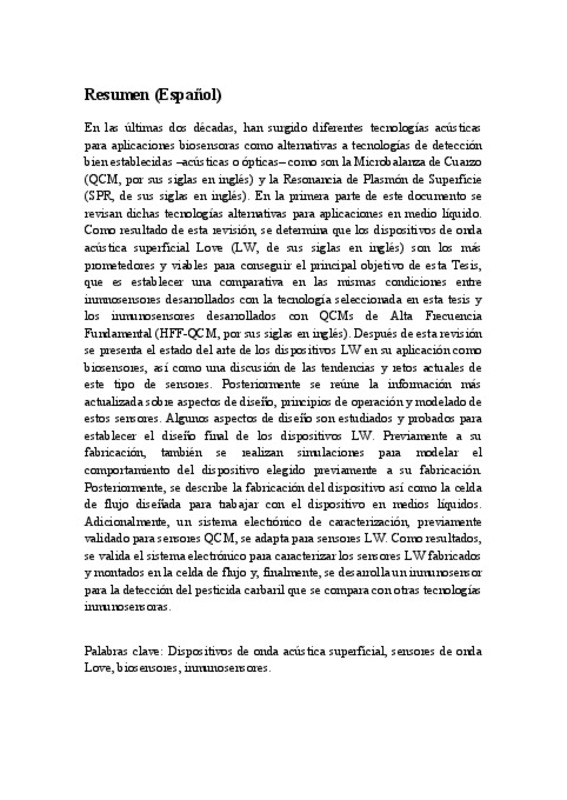Vivancos, J.; Racz, Z.; Cole, M.; Gardner, JW. (2012). Surface acoustic wave based analytical system for the detection of liquid detergents. Sensors and Actuators B: Chemical. 171:469-477. https://doi.org/10.1016/j.snb.2012.05.014
Por favor, use este identificador para citar o enlazar este ítem: http://hdl.handle.net/10251/57049
|
Título:
|
Surface acoustic wave based analytical system for the detection of liquid detergents
|
|
Autor:
|

 Vivancos, José-Luis
Racz, Zoltan
Cole, Marina
Gardner, Julian W.
Vivancos, José-Luis
Racz, Zoltan
Cole, Marina
Gardner, Julian W.
|
|
Entidad UPV:
|
Universitat Politècnica de València. Departamento de Proyectos de Ingeniería - Departament de Projectes d'Enginyeria
Universitat Politècnica de València. Instituto de Reconocimiento Molecular y Desarrollo Tecnológico - Institut de Reconeixement Molecular i Desenvolupament Tecnològic
|
|
Fecha difusión:
|
|
|
Resumen:
|
[EN] A novel analytical sensing system has been designed for the characterization and discrimination of different detergents in water. This micro-sensor system could play a key role in the development of more efficient and ...[+]
[EN] A novel analytical sensing system has been designed for the characterization and discrimination of different detergents in water. This micro-sensor system could play a key role in the development of more efficient and environmentally-friendly washing machines by enabling the measurement of residual detergents. The sensing system comprises a dual shear-horizontal surface acoustic wave (SH-SAW) resonator sensor housed within a poly-dimethylsiloxane (PDMS) microfluidic chamber. Free and electrically shorted SAW designs were used to analyze synthetic samples of liquid detergents with varying concentrations. Two anionic surfactants, namely sodium dodecylbenzene sulfonate and sodium laureth sulphate, and one non-ionic surfactant, polyoxyethylene (9.5) t-octylphenol have been studied. Dilution tests have been performed in order to determine the sensitivity or detection limit of this liquid sensing system and have been found to be ca. 10 ppm. The SAW based sensor system correctly classified all three detergents through the use of the transient signal response. Because the sensor operates without the need for a selective chemical or biological coating, it should be both robust and reliable. We believe that such technology could be used to make environmentally-friendly and greener washing machines by minimizing the use of detergents and hot water.
[-]
|
|
Palabras clave:
|
Chemical sensor
,
Detergents
,
Surface acoustic wave
,
Two-port resonator
,
Analytical systems
,
Biological coatings
,
Detection limits
,
Environmentally-friendly
,
Hot water
,
Liquid detergents
,
Microfluidic chambers
,
Polydimethylsiloxane PDMS
,
Polyoxyethylene
,
Resonator sensors
,
Sensing systems
,
Sensor systems
,
Shear horizontal surface acoustic wave
,
Sodium dodecylbenzene sulfonate
,
Sulphates
,
Surface acoustic waves
,
Transient signal
,
Acoustic surface wave devices
,
Acoustic waves
,
Acoustoelectric effects
,
Anionic surfactants
,
Chemical sensors
,
Liquids
,
Polyethylene oxides
,
Resonators
,
Sensors
,
Sodium
,
Washers
,
Washing machines
,
Soaps (detergents)
|
|
Derechos de uso:
|
Reserva de todos los derechos
|
|
Fuente:
|
Sensors and Actuators B: Chemical. (issn:
0925-4005
)
|
|
DOI:
|
10.1016/j.snb.2012.05.014
|
|
Editorial:
|
Elsevier
|
|
Versión del editor:
|
http://dx.doi.org/10.1016/j.snb.2012.05.014
|
|
Código del Proyecto:
|
info:eu-repo/grantAgreement/UPV//PAID-00-10/
|
|
Agradecimientos:
|
The authors would like to thank Frank Courtney ofthe Microsensors andBioelectronics Laboratory (Warwick University, UK)for the
fabrication of the PDMS devices. J.L. Vivancos acknowledges financial support(PAID-00-10) ofthe ...[+]
The authors would like to thank Frank Courtney ofthe Microsensors andBioelectronics Laboratory (Warwick University, UK)for the
fabrication of the PDMS devices. J.L. Vivancos acknowledges financial support(PAID-00-10) ofthe Universitat Politècnica de València for his visit to Warwick University.
[-]
|
|
Tipo:
|
Artículo
|







![[Cerrado]](/themes/UPV/images/candado.png)





